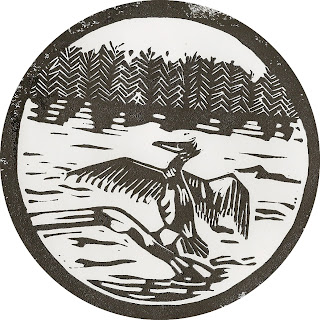art by Daurie Mangan-Dimuzio
I have to say I'm not an expert birder. But I also have to say that the birds I know, I KNOW. Great blue heron -- check. Redwing blackbird -- yep. Belted kingfisher -- sure. American goldfinch --absolutely. So today I was not at all uncertain that I saw the first cormorant of autumn as I was paddling, just upriver of the last houseboat. I was elated.
When I moved here in November, cormorants were the birds I saw most often, landing and swimming in the waters outside my window, or lined up across the river on logs along the riverbank. This is their wintering range, but when they left in spring to nest, it was so imperceptible that I didn't notice it until they were all gone. Then I really missed them.
Where did they go? I wondered today. The Audubon Bird Encyclopedia says that their nesting range (they nest April through July) is along the Pacific coast from the Aleutians to s. Baja California.
In National Geographic's Field Guide to Birds of America, it shows our area as the winter range, the coast as the year-round range, and the breeding range (I have to look with a magnifying glass to make it out) appears to be northeastern Oregon and south central Oregon.
I think I recall river people saying "our birds" go to the Oregon coast, so I will ask around to find out more.They nest on rocky coasts, and that is certainly the Oregon coast. These are double-crested cormorants, which are the only cormorants likely to be seen inland around rivers. One of their most noticeable behaviors is to hold out their wings to dry in the sun (because unlike ducks, their wings are not completely weatherproof).
Welcome back, Phalacrocorax auritus. Good to see you here again.
Added on September 26:
I have now seen 17 cormorants. Mostly singles, except the three below flying off, that were together on a log. The one on the piling is the "classic" way we see them. I have seen only two flying past my houseboat -- I am looking forward to seeing them regularly out my windows like I did all last winter.
Added on December 4:
Yesterday, directly across from me, on a wooden structure lodged in the mud, sat 28 cormorants. I counted them through my spotting scope and watched as they spread their wings to dry. Right now I see three, accompanied by a heron, and two more in the water.




No comments:
Post a Comment